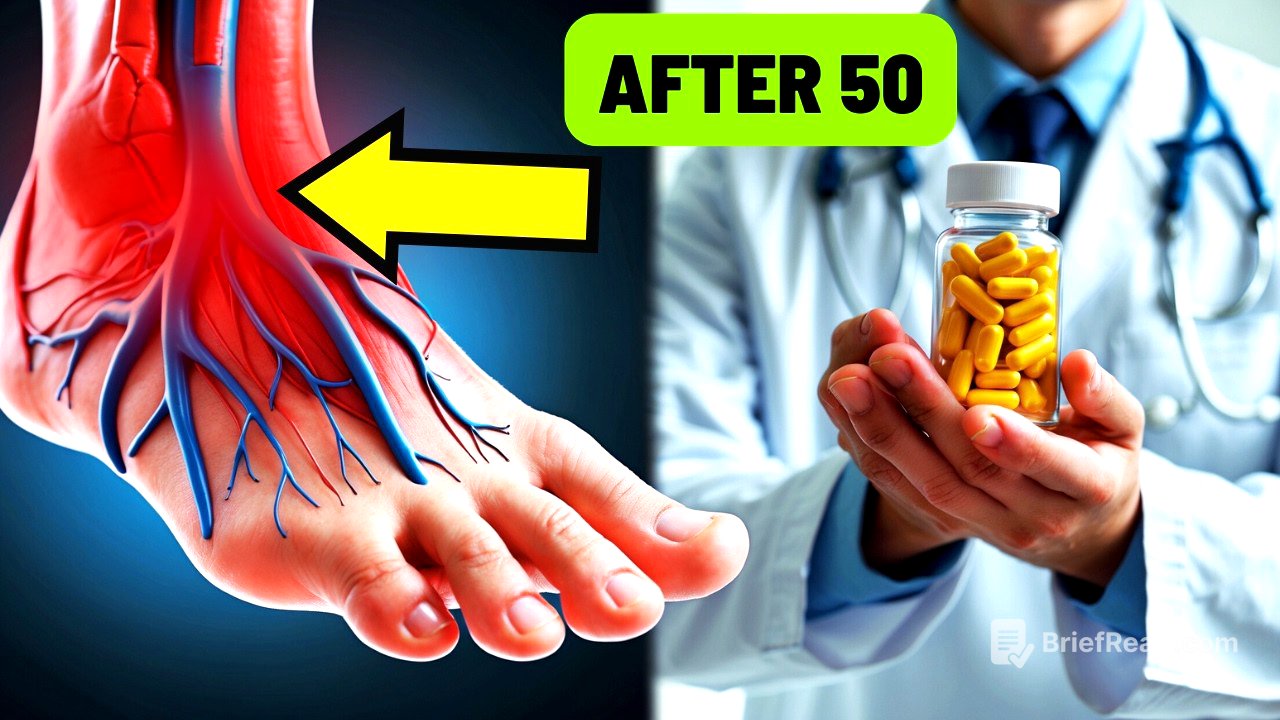TLDR;
This video discusses the importance of good blood circulation, especially in the legs and feet, and how it can be affected by age. It highlights four essential vitamins (C, B3, K, and E) that can improve circulation and five simple habits to boost their effects. The video emphasises that incorporating these vitamins and habits into your daily routine can significantly improve overall health and quality of life.
- Poor circulation affects a large percentage of adults over 50, leading to issues like heavy legs, cold feet, and tingling.
- Four key vitamins—C, B3 (Niacin), K, and E—play crucial roles in maintaining healthy blood vessels and promoting efficient blood flow.
- Simple habits like leg elevation, tiptoe walking, cold baths, leg massages, and regular exercise can significantly boost circulation.
Introduction: Understanding Poor Circulation [0:00]
The video starts by highlighting common symptoms of poor circulation, such as heavy legs and cold feet, which are often dismissed as normal signs of ageing. It reveals that over 40% of Americans over 50 experience circulation problems, which can be improved by incorporating four specific vitamins into their diet. The video promises to reveal these vitamins and simple habits to improve blood circulation.
How Blood Circulation Works [1:11]
The presenter explains blood circulation as a network of veins and arteries that transport oxygen and nutrients to cells and remove waste. When circulation is impaired, it leads to problems, especially in the legs and feet. Natural changes that occur with age, such as loss of blood vessel flexibility, plaque buildup, less efficient vein valves, changes in blood thickness, and reduced physical activity, can affect circulation.
Six Warning Signs of Poor Circulation [3:50]
The video outlines six warning signs that indicate poor circulation: numbness and tingling in the legs and feet, constantly cold feet, frequent muscle cramps, changes in skin colour, varicose veins, and restless leg syndrome. These signs are important indicators that should not be ignored, as they signal that the body is not receiving adequate blood flow and nutrients.
Vitamin C: The Blood Vessel Strengthener [8:51]
Vitamin C is essential for maintaining healthy blood vessels by promoting collagen production, preventing blood clots, reducing inflammation, and acting as a powerful antioxidant. Good sources of vitamin C include citrus fruits, strawberries, leafy vegetables, beets, carrots, tomatoes, avocados, and bananas. The recommended daily intake is 90 mg for men and 75 mg for women, and it's best to consume these foods fresh to retain their vitamin C content.
Vitamin B3 (Niacin): The Cholesterol Regulator [11:09]
Vitamin B3, or niacin, is vital for circulation health, strengthening blood vessels, regulating cholesterol levels, benefiting brain circulation, and supporting individuals with type 2 diabetes. Niacin helps reduce bad cholesterol (LDL) and increase good cholesterol (HDL), preventing plaque buildup in arteries. Good sources include lean meats, fish, eggs, nuts, seeds, legumes, and whole grains. While niacin is safe when consumed through foods, high-dose supplements can cause side effects, so consulting a healthcare professional is recommended before starting supplementation.
Vitamin K: The Calcium Redirection Expert [13:18]
Vitamin K plays crucial roles in circulation and bone health by balancing blood clotting, preventing varicose veins, redirecting calcium to bones, and preventing arteriosclerosis. It ensures proper blood solidification without unnecessary clot formation and helps prevent calcium buildup in arteries. Good sources include dark green leafy vegetables, fruits like kiwi and grapes, nuts, cheeses, and soy-based products.
Vitamin E: The Miracle Vitamin for Circulation [15:12]
Vitamin E is highlighted as a "miracle" vitamin for blood circulation, especially for those over 50. It acts as a potent antioxidant, protecting body tissues from damage caused by free radicals, dilating blood vessels, reducing blood pressure, preventing blood clots, protecting against oxidative stress, and improving peripheral circulation. Good sources include vegetable oils, nuts and seeds, green vegetables, fortified cereals, avocado, and fatty fish.
Five Simple Habits to Boost Circulation [18:22]
The video shares five simple habits to enhance the effects of the vitamins: leg elevation, walking on tiptoes, cold baths on legs, leg massages, and regular physical exercise. Leg elevation helps blood flow back to the heart, reducing pressure in leg veins. Walking on tiptoes strengthens leg muscles and stimulates circulation. Cold water causes blood vessels to contract and dilate, strengthening them. Leg massages help push blood toward the heart and relax tense muscles. Regular exercise improves circulation, strengthens the heart, and improves blood vessel elasticity.
Conclusion: Incorporating Natural Solutions [23:49]
The video concludes by emphasising that incorporating these vitamins and habits into your daily routine can significantly improve circulation and overall quality of life. It advises consulting a doctor for serious circulation problems and encourages viewers to share their experiences in the comments. The presenter reminds viewers that consistency is key and that small changes can lead to significant benefits.









